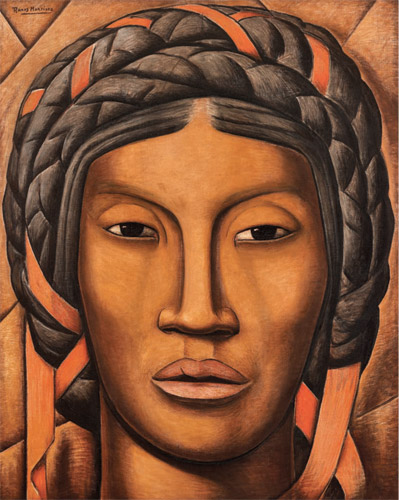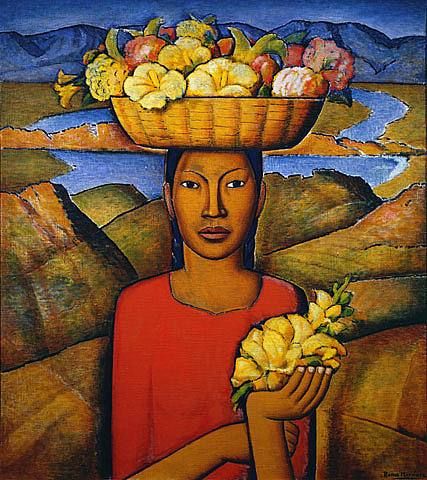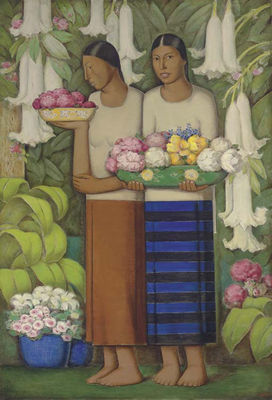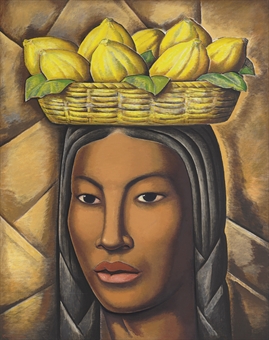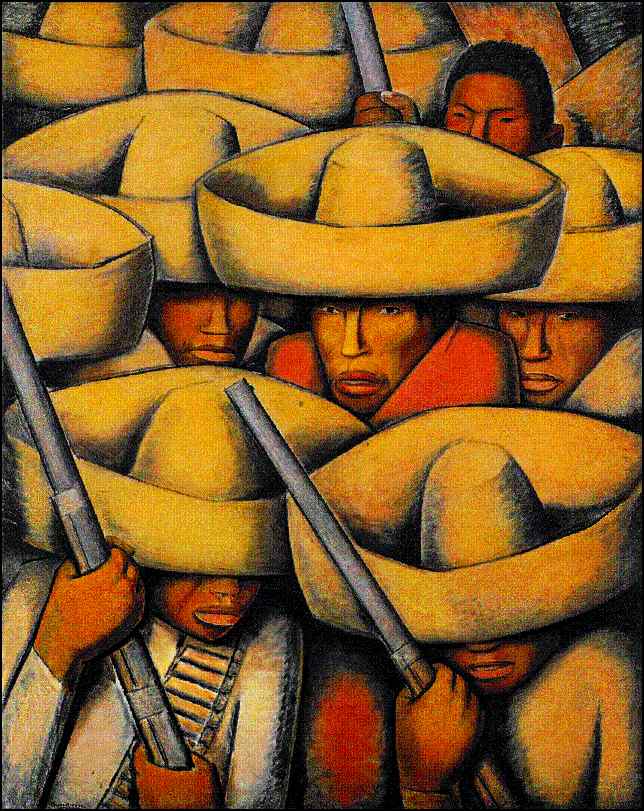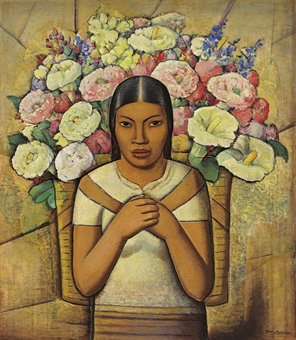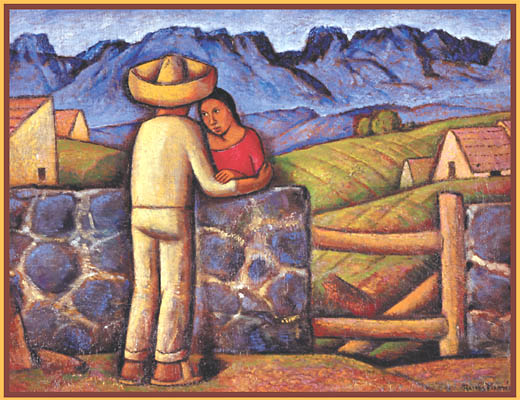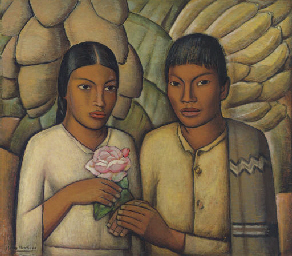<Back to Index>
- Painter Alfredo Ramos Martínez, 1871
PAGE SPONSOR
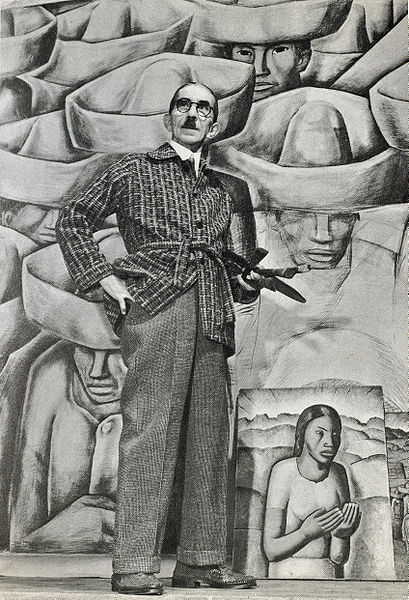
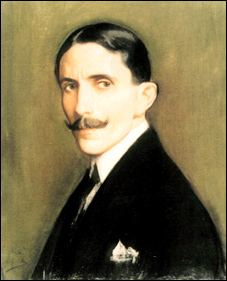
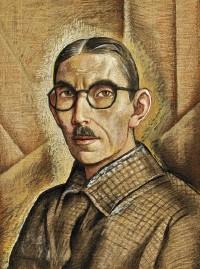
Alfredo Ramos Martínez (November 12, 1871 in Monterrey, Nuevo León, Mexico – November 8, 1946 in Hollywood, California) was a painter and muralist who lived and worked in Mexico, Paris, and Los Angeles. Considered by many to be the father of Mexican Modernism, Ramos Martínez was a celebrated artist and educator best known for his serene and empathetic portraits of traditional Mexican people and scenes. As the poet Rubén Darío wrote, "Ramos Martínez is one of those who paints poems; he does not copy, he interprets; he understands how to express the sorrow of the fisherman and the melancholy of the village.”
Ramos Martínez was born in 1871 in Monterrey, Nuevo León, the ninth child of Jacobo Ramos and his wife Luisa Martinez. His father was a successful merchant trading in jewelry, fine fabrics, silver, embroidered suits and hand - woven sarapes from Saltillo. All members of the Ramos Martinez family were involved with their father’s business and it was expected that the artist, too, would one day join the ranks of “honorable merchant”. However, Ramos Martinez’s gifts and instincts propelled him towards a career in the arts; a choice that his family ultimately supported.
At the age of fourteen, one of Ramos Martinez's drawings, a portrait of the governor of Monterrey, was sent to an exhibition in San Antonio, Texas, and won first prize. A portion of that prize included a scholarship to study at the most prestigious art school in all of Mexico, Academia Nacional de Bellas Artes in Mexico City. Thus the entire Ramos Martinez family relocated to Coyoacan, a small town on the outskirts of Mexico City.
From the beginning Ramos Martinez was recognized as prodigiously talented. His favored medium was watercolor and he won numerous awards for his achievements. Though he found the teaching methods at the Academy repressive and counter - intuitive to his more emotional plein aire impulses, Ramos Martinez created a significant body of work that he was able to sell while still a student. Gratifying as his youthful accomplishments were, the news from France, and the examples of the brilliance of the Impressionist and Post - Impressionist artists, persuaded the young painter that he needed to be in Europe to continue his education and define his career. Though his family was by no means poor, they did not have funds to support Ramos Martinez’s European dream.
In a supreme bit of good fortune, Phoebe Hearst attended a dinner in Mexico City for the President of Mexico, Porfirio Diaz,
which featured place mats designed and painted by the young Ramos
Martinez. Mrs. Hearst was so impressed with the decoration that she
asked to meet the artist and see other examples of his work. After their
meeting, Mrs. Hearst not only bought all of Ramos Martinez’s
watercolors, but agreed to provide financial support for the artist’s
continued study in Paris.
Ramos Martinez’s arrival in Paris in 1900 coincided with further development of the Post - Impressionist movement. He was able to see firsthand the work of Gauguin, Van Gogh, Matisse, Monet, Seurat and Odilon Redon. Furthermore, Mrs. Hearst’s monthly stipend of 500 francs, combined with Ramos Martinez’s fluent French, afforded him a comfortable life style and the ability to travel throughout Europe.
While in Paris, Ramos Martinez attended various artistic and literary salons and made the acquaintance of the renowned Nicaraguan poet, Rubén Dario. Dario and Ramos Martinez became fast friends, thus insuring Ramos Martinez’s inclusion in a circle of rather extraordinary bon vivants such as Isadora Duncan, Paul Verlaine, Eleanora Duse, Rémy de Gourmont and Anna Pavlova.
Dario wrote at length about the painterly and literary ideas that defined the creative output of both artists during those years. The two sojourned to Belgium and Holland to study the works of Rembrandt van Rijn and Vincent van Gogh. The artist’s works from this period are strongly influenced by the somber tonalities of sky and sea.
Also, it was in Brittany, that Ramos Martinez began painting on newsprint, a material / medium he used to superb effect during his years in California. When the artist discovered he had run out of drawing paper, he asked the concierge at the Inn where he was staying during a holiday weekend if he had any paper suitable for drawing. The gentleman offered him newsprint in abundance.
In 1905, Ramos Martinez began participating in the yearly Salon d'Automne, perhaps the most important of all the salons of that era. Within a year of his first showing there, his painting Le Printemps was awarded the Gold medal.
However, after this great acknowledgment, Mrs. Hearst decided she would no longer give him his monthly stipend and Ramos Martinez began the struggle of earning his living as an artist.
Ramos Martinez showed at a number of galleries in Paris. One of the leading art critics of the day, Camille Mauclair wrote that the work of Ramos Martinez was in the same class as the finest Impressionist landscapes exhibited in Paris. Though
the sale of his artwork was proceeding, and Ramos Martinez had achieved
a degree of comfort as a ‘Parisian’, in 1909 he felt a strong desire to
return home to Mexico.
By the time Ramos Martinez arrived in early 1910, Mexico was a nation in turmoil. The Mexican Revolution was beginning in earnest and the 30 year rule of President Porfirio Diaz was on the verge of collapse due to the pressure of the political reforms of Francisco I. Madero. Within a year of the President’s resignation in 1911, the art students at the National Academy called a strike in order to protest the “aesthetic dictatorship” of the Academy. They demanded the establishment of a “Free Academy” and proposed Ramos Martinez as director. Hailed as a distinguished alumni, a bona fide European success and sympathetic to the students’ cause, Ramos Martinez became first the assistant Director and, by 1913, the Director of the Academy.
Now, as Director, he was able to open the first of his Open Air Schools of Painting. With the example of the Impressionists and Post - Impressionists in mind and fortified by his sense of the primacy of the artist’s personal vision, Ramos Martinez’s Open Air Schools redefined the nature of artistic instruction in Mexico.
The first school was established in Santa Anita Ixtapalapa with an initial class of 10 boys, including David Alfaro Siqueiros, Federico Cantú who later became a noted Mexican muralist. By 1914, Ramos Martinez stepped down as Director of the Academy but opened another Open Air School in Coyoacan. That same year, his student’s work was featured in the Exhibition of Works from Public and Art Schools at the Spanish Pavilion and met with extremely favorable response.
The political situation in Mexico remained extremely volatile for the next decade and by 1920 Ramos Martinez was reinstated as Director of the Academy. Despite all the politics, the Open Air Schools flourished and Ramos Martinez was acknowledged as a true innovator in the Mexican art world or, as he is frequently referred to, the “Father of Modern Mexican Art”. To quote Ramon Alvade la Canal in “Los acaparadores de murales”, “... the true force behind contemporary Mexican painting wasn’t Diego Rivera; it was Alfredo Ramos Martinez”.
While Ramos Martnez invested a majority of his energy in teaching and the establishment of his Open Air Schools, he also continued his own work as a painter. In 1923, he was awarded the Grand Cross of the Order of Leopold by King Albert of Belgium in recognition of his contributions to the visual arts.
In 1928, Ramos Martinez married Maria de Sodi Romero of Oaxaca.
Their daughter, Maria was born one year later, suffering from a
crippling bone disease. Ramos Martinez resigned as Director of the
Academy and sought treatment for his daughter’s condition. The family
traveled to the Mayo Clinic in
Rochester, Minnesota, and eventually resolved to settle in the milder
climate of Los Angeles, with Maria under the care of Dr. John A. Wilson.
Having relocated to Los Angeles in 1929, Ramos Martinez was offered an exhibition by William Alanson Bryan, Director of the Los Angeles County Museum of Art at Exposition Park. A number of subsequent exhibitions followed, with Martinez developing a strong following in the Hollywood community.
Well known Warner Brothers art director and interior decorator to the stars Harold Grieve acquired a number of works by the artist and championed the artist’s work to his clients. Noted directors Ernst Lubitsch, and Alfred Hitchcock, costume designer Edith Head, writer Jo Swerling and actors Charles Laughton, Gary Cooper, James Stewart, and Beulah Bondi, among others, were collectors.
Ramos Martinez was also exhibited with great success in San Diego at the Fine Arts Gallery of Balboa Park and in San Francisco at the California Palace of the Legion of Honor. It was there that celebrated Bay Area art patron Albert Bender first saw Ramos Martinez’ work. Bender became a lifelong friend of the artist and acquired numerous works for his personal collection. Further more, he purchased and donated Ramos Martinez works to the collections of the Legion of Honor, the San Francisco Museum of Art, the California Historical Society and Mills College.
In addition to his mastery of all conventional media including drawing, printmaking, watercolor, and easel painting, Ramos Martinez was an extremely skilled muralist who excelled in the technically challenging art of traditional fresco painting. Though a number of his murals were destroyed, ncluding the Chapman Park Hotel mural (adjacent to the famous Brown Derby Restaurant) and the Normal School for Teachers (Escuela Normal) in Mexico City, several examples are still viewable: the Chapel of the Santa Barbara Cemetery (1934); the La Avenida Café (Coronado, now the Coronado Public Library); and the beautiful unfinished Margaret Fowler Frescoes, Scripps College, Claremont (1945). The Scripps mural was commissioned by the College at the urging of Millard Sheets, the much loved California artist and long time admirer of Ramos Martinez. One of Ramos Martinez' most significant frescoes, the "La Guelaguetza", named after the ancient Oaxacan celebration of the Earth's abundance, was commissioned in 1933 by screenwriter Jo Swerling for his North Rodeo Drive home in Beverly Hills. Having fallen into obscurity for many years it was rescued before demolition of the residence in 1990.
Alfredo
Ramos Martinez died unexpectedly at the age of 73 on November 8, 1946
in Hollywood, California. He was buried at Holy Cross Cemetery. At the
time of his death, Ramos Martinez was working on an extensive mural at Scripps College. The mural has been left unfinished as a tribute to him.
After the artist’s death, the Dalzell Hatfield Gallery in Los Angeles continued to showcase the paintings and drawings. Maria Sodi de Ramos Martinez, the artist’s widow, saw to it that Ramos Martinez was included in numerous gallery exhibitions. Up until her death in 1985, she functioned as the primary champion of her late husband’s work.
In 1991, Louis Stern presented the first major retrospective of the artist’s work since his death. The exhibition, Alfredo Ramos Martinez (1872 – 1946) opened at Louis Stern Galleries in Beverly Hills on October 1 and continued through January 6, 1992. This exhibition was the foundation of the monumental Ramos Martinez’ exhibition, Alfredo Ramos Martínez (1871 – 1946) Une Visión Retrospectiva, at Mexico City’s renowned Museo Nacional de Arte (MUNAL) in April of that same year.
These
two exhibitions became the cornerstones of a re-examination of Ramos
Martinez’s work and subsequent development of the market for these
works. As with the other major Mexican Modernists, indigenous peoples
were the principal subjects in the mature works of Ramos Martinez. In
recent years, several of these paintings have realized high prices on
the international art market. His 1938 "Flowers of Mexico" brought over
$4 million at Christie's in a New York auction in May 2007.
